Recent Posts
Home >Unlabelled > 'Sesame Street: Once Upon A Monster': Preview - Gaming News on Astini News
'Sesame Street: Once Upon A Monster': Preview - Gaming News on Astini News
Posted on Thursday, September 8, 2011 by astini
Sesame Street: Once Upon A Monster puts young players in a motion-controlled world of happy songs, bright colours and much-loved characters such as Elmo, Cookie Monster and Oscar The Grouch. So, let us tell you how to get to Sesame Street...
Introduction
Sesame Street: Once Upon A Monster is a new video game that will allow players both young and young-at-heart to join the Sesame Street characters on an interactive storybook adventure.
Developed by Brütal Legend studio Double Fine Productions, the game is part of a new exclusive publishing arrangement between Warner Bros and Sesame Street, the US children's broadcaster that has won multiple Grammy and Emmy awards over its 42 years on air.
Made exclusively for Xbox Kinect, Once Upon A Monster sees 4 to 8-year-olds (and their families) enter a motion-controlled world of mini-games, vibrant colours and lashings of fun. Digital Spy joined the Sesame Street gang to see if this is one story worth telling.
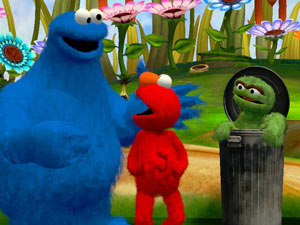
© Warner Bros Interactive
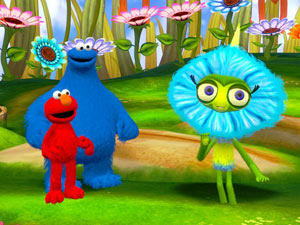
© Warner Bros Interactive
An interactive storybook born out of amnesia fortnight
Sesame Street: Once Upon A Monster came about during "amnesia fortnight", a two-week period at Double Fine which occurred when the studio's Brütal Legend game was temporarily without a publisher.
Studio founder Tim Schafer split the company into four teams and asked each to work on a new video game project that would not require a full development team of around 60-70 people, but instead could be produced more quickly and easily as a downloadable game.
What resulted was Stacking, Trenched, Costume Quest and the outlines of Sesame Street: Once Upon A Monster. The latter started off as a game called Happy Song, featuring a range of monsters created by Double Fine, but then Warner Bros signed a deal with Sesame Street and asked the studio to become the exclusive developer of all new Sesame Street video games.
It didn't take a great leap of inspiration to connect the Sesame Street IP with Happy Song, and when Microsoft came along with motion controller Xbox Kinect, it completed the package and Sesame Street: Once Upon A Monster was born.
Jon Katz of Double Fine said that Kinect is perfect for this kind of game as the interface is "approachable" for younger audiences. The game is essentially an "interactive storybook", and players can work their way through the chapters; playing mini-games, watching the cut scenes and absorbing a bit of "stealth learning" along the way.
Sesame Street: Once Upon A Monster features four characters from Sesame Street - Cookie Monster, Elmo, Oscar the Grouch and Grover - along with a range of monsters created by Double Fine. Throughout the adventure, players will be helping a range of creatures-in-distress by jumping, flapping and generally getting active.

© Warner Bros Interactive
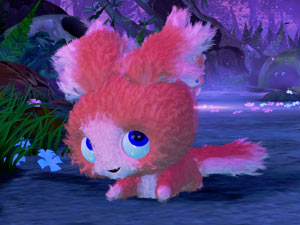
© Warner Bros Interactive
Trash-catching, flower-tuning, arm-flapping fun
The demo started by opening the story book by holding your hands up, twisting the lock and turning over the page. Each chapter in the game is the story of one particular monster, who has a particular problem that Sesame Street's version of The A-Team must sort out.
We tried out Shelby's chapter, a kind of bug-like creature whose garden has turned into a refuse tip (that's council budget cuts for you...). Elmo, Cookie Monster and Oscar decide to help Shelby clear up her garden, despite the fact that the Grouch rather likes it as it is.
The first mini-game involved holding up your hands as though you were catching a ball, and then grabbing the rubbish flying around in the air and throwing it into Oscar's trash can. It took a little while to work out the required trajectory and power of the throws, but overall the game felt responsive and fun.
After clearing a certain area, the chapter moves the player on to tidy up other parts of the garden, varying the challenge slightly, such as throwing green rubbish into green bins and red into red. The chapter also contained other challenges, such as one where Elmo and Cookie put on bee wings to fly up a plant and encourage its flowers to bloom.
This challenge involved flapping your arms to propel the characters upwards, leaning left and right to steer and also gliding on upcurrents ejected by flower heads. Eventually, we reached the top, but not without giving our arms a pretty decent workout.
As expected, the graphics are bright, colourful, vibrant but also true to the Sesame Street universe. The four famous characters appear authentic and expressive, particularly as we played the game on a giant cinema screen with nowhere for errors to hide.
Elsewhere in the Shelby chapter, there was a plant-growing challenge, and a musical one too. Happy Song originally focused on the experience of building songs that could make people happy, and the roots of this can be seen in Once Upon A Monster.
In this challenge, players have to bring some harmony back to the fetid garden by recreating 'Twinkle Twinkle Little Star' with some tuneless flowers. Getting the flowers in tune involved looking at blooms set in two rows to see if they were looking up or down, indicating the direction they want to go in to get back to musical harmony. You then have to raise up or duck down with your body to get the flowers smiling again and strike the right notes.
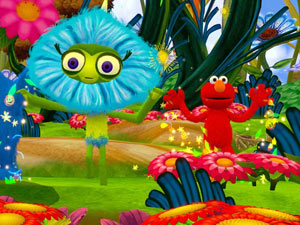
© Warner Bros Interactive
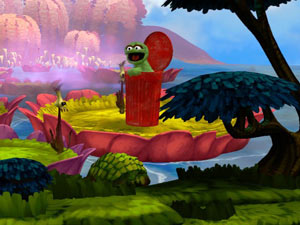
© Warner Bros Interactive
Co-operative play, "stealth learning", and bonus content
Each chapter takes around 30 minutes to complete and is a self-contained story, which Katz said was a deliberate move so that parents could manage how long children should play the game.
Once Upon A Monster supports drop in/drop out co-operative play for two players, and Double Fine is also keen for the game to be used by the whole family.
While going through the chapters, players earn stars for achievements in the mini-games, which unblock bonus content, such as concept art and developer videos in a sticker book format.
A central tenant of Sesame Street's ethos is education and this has been incorporated into the game, but don't expect alphabet and numbers tuitions; rather, the game focuses on what Katz's terms "stealth learning".
Each chapter has a different social lesson, such as the environmental message in Shelby's adventure, or the section featuring Seamus the monster, who wants to put on a play but is too shy to get it together. The player must help him overcome his social awkwardness to get the show on the road.
The pleasing thing about Sesame Street: Once Upon A Monster is that Double Fine appears to have hit its target market dead on, creating a game that uses Kinect intelligently, serves the Sesame Street brand and will also appeal to both children and their parents.
The colours are fun and bright, the mini-games varied and interesting, while the education that is so crucial to Sesame Street is veered into new areas, such as lifestyle and social skills.
Asked about how video games are perceived these days by parents, Katz stressed that many people within Double Fine have children and so they are acutely aware of the needs of families.
He accepted that Once Upon A Monster players will "not be out in the sunshine getting grass stains on their trousers", but stressed that they will still get active playing the game, while also having fun and learning the Sesame Street way.
Sesame Street: Once Upon A Monster will be released exclusively on Kinect for Xbox 360 on October 11.
Blog Archive
-
▼
2011
(2934)
-
▼
September
(682)
- This family’s favourite kitchen tool is a comput...
- News - The Neshoba Democrat on Astini News
- News: Mozambique proposes law to axe VAT on animal...
- Try Thanksgiving in Belize, Says The Lodge at Chaa...
- The Origin Of The Word 'Epilepsy' : NPR on Astini ...
- Arizona to host GOP presidential debate in Decembe...
- Schizophrenia - Pipeline Review, H2 2011 on Astini...
- Nicolas Cage on 'The Expendables 2' and 'Ghost Rid...
- Who deserves 2011 PGA Tour Player of the Year hono...
- Lille midfielder Joe Cole targets England recall o...
- What is Sonic the Hedgehog Without a Sega Console?...
- Salespeople at three Bob's Discount Furniture stor...
- on Astini News
- Stocks ending gloomy 3rd quarter on a weak note - ...
- BLABBERMOUTH.NET on Astini News
- Does it work? Can maca increase sexual appetite? -...
- Giants trying to avoid 'trap' vs. Cardinals on Ast...
- Sharpshooting Fairfield detective places 11th on H...
- Obama's race problem is black and white -- and gre...
- Premier League football news from the Barclays Pre...
- HBO Marketing Chief Courteney Monroe to Step Down ...
- 750 pieces of John Wayne's life on the block - Loc...
- Present-Day Republican Rage Pre-Dates the Tea Part...
- Frances Bean Cobain | Frances Bean Cobain Turns To...
- OS X Lion / Snow Leopard Now Required to play 'Cit...
- Nassau County detective quitting over allegation s...
- Daniel Radcliffe A 'Star Wars' Virgin - Entertainm...
- Google Fights German Lawsuit Over ‘Sex-Club Bill...
- New ACDSee Photo Editing and Management Products D...
- ROM – @nickmcminn60 MIUI SS-8 “LG 2X Editionâ€...
- George Clooney Defends Ex Elisabetta Canalis From ...
- IRONCLAD (2011) on Astini News
- Actors Who Should Win And Who Will Win (PHOTOS) on...
- Young Canadians are creating a better world on Ast...
- Nine Named Semifinalists For 2012 Kentucky Teacher...
- Be Trafalgar’s guest by watching Better Homes & ...
- Grocery stores expanding generic brands on Astini ...
- Summer over, Cape road work abounds on Astini News
- Charles Manson and Me: A Memoir on Astini News
- Your Kid’s Brain, SpongeBob-ed | NewAmerica.net ...
- Extreme Weather Leads To Spike In Sales on Astini ...
- Australia ruling in Apple vs Samsung case expected...
- Titan Medical Inc. Announces Memorandum of Underst...
- DAILY YOMIURI ONLINE (The Daily Yomiuri) on Astini...
- A gluten-free for all drives product sales | Reute...
- Space Shuttle Enterprise Unveiled 35 Years Ago to ...
- Prime Limousine, Audi sign deal on 100 Audis for E...
- South Africa ponders issuing visa for Dalai Lama o...
- 'We the People' captures American spirit | MyCentr...
- on Astini News
- Neil Young’s book deal sparks hunt for Canadian ...
- The Sweet Smell of Easier Weight Loss? on Astini News
- Living | Angry Birds game may top holiday toy sale...
- SEC probes RBS,Credit Suisse over bad mortgage loa...
- Top 100 ALA Banned Books: Harry Potter | The Back ...
- I-Team 10 investigation: Pizzeria employee accused...
- US scientists testing earthquake early warning - T...
- Holy Land 9/3/11 - Celebrity Review by tigershark1...
- J. Cole on His Album’s Eleventh-Hour Jay-Z Verse...
- Bowling for a Cause - Yahoo! Finance on Astini News
- Car Charging Group to Provide EV Charging Services...
- PR-USA.net on Astini News
- Arkham City Xbox 360 Bundle Shows Up on German Ama...
- Braylon Edwards has knee procedure, out a while - ...
- Tea Party Group to Form Super PAC on Astini News
- New Jersey Mining Company Intersects 5.07 g/t Gold...
- 'Your Highness' is supposed to be stupid; it succe...
- Analyzing The Price-To-Cash-Flow Ratio - Yahoo! Fi...
- : Movies :: News :: Paste on Astini News
- ASIC to review broker capital rules: report | News...
- Portuguese Man o' War threat underestimated by swi...
- UK professor 'reconstructs' lost Beethoven piece |...
- Award-winning producer Jon Blair joins Aljazeera o...
- Diablo 3 Community Site Offers Peak at Game's Trea...
- Valencia vs. Chelsea: Champions League Match Will ...
- Tinker, Tailor, Soldier, Spy would have been so mu...
- Anna Faris answers film question "What's Your Numb...
- Guild Wars 2 Closed Beta Still Coming This Year --...
- Listen To The Weeknd Remix Of Florence + The Machi...
- Blackberry Mom: Shel Silverstein truly inspiring o...
- Deal watch: Norwegian Cruise Line launches another...
- AQM Announces the Discovery of the New Victoria Po...
- Ludacris, Bay City Rollers hit town in November on...
- Kim Kardashian leaves wedding ring home - Entertai...
- Voting important for youth - EEC on Astini News
- Buy Dish TV; target price raised, stock is getting...
- Weather Underground Launches Its New Weather API P...
- A victory for common sense on Astini News
- The top Typing Games Every Kid Have to Have! – E...
- Game: "Martians Vs. Goblins" F. Tyler The Creator ...
- Column: With Bielema playing ‘respect’ card, N...
- East Valley Tribune - Arizona Local News on Astini...
- Pan-Seared Chicken with Chicory, Bacon & Figs on A...
- Tax filing relief to those hurt by Hurricane Irene...
- DTS and Huawei Showcase Superior Audio Technologie...
- 'Paradise Lost' director Joe Berlinger sought just...
- Samsung Mobile Announces New Expansion of Galaxy F...
- 'Revolutionary,' Controversial Idea : NPR on Astin...
- J. Cole Is a Storyteller in 'Daddy's Little Girl' ...
- IIS 7.0 Detailed Error - 503.4 on Astini News
-
▼
September
(682)